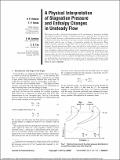A Physical Interpretation of Stagnation Pressure and Enthalpy Changes in Unsteady Flow
Author(s)
Hodson, H. P.; Hynes, T. P.; Greitzer, Edward M; Tan, Choon S
Download060902_1.pdf (919.2Kb)
PUBLISHER_POLICY
Publisher Policy
Article is made available in accordance with the publisher's policy and may be subject to US copyright law. Please refer to the publisher's site for terms of use.
Terms of use
Metadata
Show full item recordAbstract
This paper provides a physical interpretation of the mechanism of stagnation enthalpy and stagnation pressure changes in turbomachines due to unsteady flow, the agency for all work transfer between a turbomachine and an inviscid fluid. Examples are first given to illustrate the direct link between the time variation of static pressure seen by a given fluid particle and the rate of change of stagnation enthalpy for that particle. These include absolute stagnation temperature rises in turbine rotor tip leakage flow, wake transport through downstream blade rows, and effects of wake phasing on compressor work input. Fluid dynamic situations are then constructed to explain the effect of unsteadiness, including a physical interpretation of how stagnation pressure variations are created by temporal variations in static pressure; in this it is shown that the unsteady static pressure plays the role of a time-dependent body force potential. It is further shown that when the unsteadiness is due to a spatial nonuniformity translating at constant speed, as in a turbomachine, the unsteady pressure variation can be viewed as a local power input per unit mass from this body force to the fluid particle instantaneously at that point.
Date issued
2012-09Department
Massachusetts Institute of Technology. Department of Aeronautics and AstronauticsJournal
Journal of Turbomachinery
Publisher
ASME International
Citation
Hodson, H. P. et al. “A Physical Interpretation of Stagnation Pressure and Enthalpy Changes in Unsteady Flow.” Journal of Turbomachinery 134, 6 (2012): 060902 © 2012 American Society of Mechanical Engineers
Version: Final published version
ISSN
0889-504X